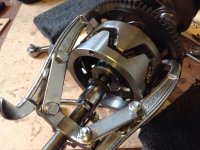We noticed you are blocking ads. DO THE TON only works with community supporters. Most are active members of the site with small businesses. Please consider disabling your ad blocking tool and checking out the businesses that help keep our site up and free.
You are using an out of date browser. It may not display this or other websites correctly.
You should upgrade or use an alternative browser.
You should upgrade or use an alternative browser.
Cb750 rotor stuck
- Thread starter Finnigan
- Start date
SONICJK
Reminds me of...me No, I'm sure of it. I hate him
Is it threaded inside?
I know most of my hondas have internal threads that you screw a M16 fine thread bolt into and hit it with an impact wrench and it pops right off.
The puller should work though. Use an impact wrench on the puller nut, its the quick smacking action that breaks it loose.
If you don't have one, use a box end wrench and a hammer.
I know most of my hondas have internal threads that you screw a M16 fine thread bolt into and hit it with an impact wrench and it pops right off.
The puller should work though. Use an impact wrench on the puller nut, its the quick smacking action that breaks it loose.
If you don't have one, use a box end wrench and a hammer.
Hoosier Daddy
Earache my eye...
Why am I thinking the rear axle screws into the rotor and used as a puller? :
Might be wrong but think I remembered that from somewhere...
Might be wrong but think I remembered that from somewhere...
That must have been a relief.
Smarter people than me designed it, but I don't get why rotors need to be such a pain to pull. Is it the weight of the rotor that requires it to be so solidly mounted to the crank? Lot of other heavy assemblies spin at the same or similar RPM (clutch basket springs to mind) but simply slide on. Is it because the rotor is a 'consumable' and therefore they don't want to invest in complex machining to have a secure mount that is also easy to remove like the gears on the transmission as another example?
Smarter people than me designed it, but I don't get why rotors need to be such a pain to pull. Is it the weight of the rotor that requires it to be so solidly mounted to the crank? Lot of other heavy assemblies spin at the same or similar RPM (clutch basket springs to mind) but simply slide on. Is it because the rotor is a 'consumable' and therefore they don't want to invest in complex machining to have a secure mount that is also easy to remove like the gears on the transmission as another example?
surely as an engineer you know that the crankshaft expands at excactly the same rate as the flywheel ? it is a very close to a self holding taper, that is what it is called in engineer speak,only a narrow range of tapers fits this descriptioncxman said:as an engineer i have often thought that what happens is the retainer bolt provides inward tension (tightening)
and constant low level heating and cooling causes expansion and contraction
that must tighten it on the taper over time
JMO
with a proper puller they come right off no issuesTim said:That must have been a relief.
Smarter people than me designed it, but I don't get why rotors need to be such a pain to pull. Is it the weight of the rotor that requires it to be so solidly mounted to the crank? Lot of other heavy assemblies spin at the same or similar RPM (clutch basket springs to mind) but simply slide on. Is it because the rotor is a 'consumable' and therefore they don't want to invest in complex machining to have a secure mount that is also easy to remove like the gears on the transmission as another example?
it is designed to be securely attached for years of continuous service and taper fits the bill nicely
the rotor when charging and under full load runs hotter than the crank end sometimes by as much as 30 degrees warmer
while running and may not equalize till hot soak
so it could be slightly expanded and over time tighten due to tension
as the rotor tightens onto the crank over time i would suspect i am correct
and it would be a easy thing to test i will see if i can find any data on it as i am sure its been done before
while running and may not equalize till hot soak
so it could be slightly expanded and over time tighten due to tension
as the rotor tightens onto the crank over time i would suspect i am correct
and it would be a easy thing to test i will see if i can find any data on it as i am sure its been done before
kraptastic k
ask me how i got here
That rotor held my CB project up for almost 8 months. Glad to hear you got it.





